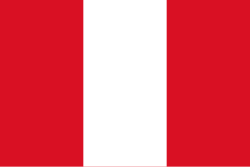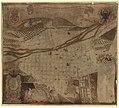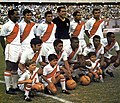Portal:Peru
Introduction
Peru, officially the Republic of Peru, is a country in western South America. It is bordered in the north by Ecuador and Colombia, in the east by Brazil, in the southeast by Bolivia, in the south by Chile, and in the south and west by the Pacific Ocean. Peru is a megadiverse country, with habitats ranging from the arid plains of the Pacific coastal region in the west, to the peaks of the Andes mountains extending from the north to the southeast of the country, to the tropical Amazon basin rainforest in the east with the Amazon River. Peru has a population of over 32 million, and its capital and largest city is Lima. At 1,285,216 km2 (496,225 sq mi), Peru is the 19th largest country in the world, and the third largest in South America. Peruvian territory was home to several cultures during the ancient and medieval periods, and has one of the longest histories of civilization of any country, tracing its heritage back to the 10th millennium BCE Caral–Supe civilization, the earliest civilization in the Americas and considered one of the cradles of civilization. Notable succeeding cultures and civilizations include the Nazca culture, the Wari and Tiwanaku empires, the Kingdom of Cusco, and the Inca Empire, the largest known state in the pre-Columbian Americas. The Spanish Empire conquered the region in the 16th century and Charles V established a viceroyalty with the official name of the Kingdom of Peru that encompassed most of its South American territories, with its capital in Lima. Higher education started in the Americas with the official establishment of the National University of San Marcos in Lima in 1551. Peru's population includes Mestizos, Amerindians, Europeans, Africans and Asians. The main spoken language is Spanish, although a significant number of Peruvians speak Quechuan languages, Aymara, or other Indigenous languages. This mixture of cultural traditions has resulted in a wide diversity of expressions in fields such as art, cuisine, literature, and music. (Full article...) Entries here consist of Good and Featured articles, which meet a core set of high editorial standards.
A pisco sour is an alcoholic cocktail of Peruvian origin that is traditional to both Peruvian and Chilean cuisine. The drink's name comes from pisco, a brandy which is its base liquor, and the cocktail term sour, implying sour citrus juice and sweetener components. The Peruvian pisco sour uses Peruvian pisco and adds freshly squeezed lime juice, simple syrup, ice, egg white, and Angostura bitters. The Chilean version is similar, but uses Chilean pisco and Pica lime, and excludes the bitters and egg white. Other variants of the cocktail include those created with fruits like pineapple or plants such as coca leaves. Although the preparation of pisco-based mixed beverages possibly dates back to the 1700s, historians and drink experts agree that the cocktail as it is known today was invented in the early 1920s in Lima, the capital of Peru, by the American bartender Victor Vaughen Morris. Morris left the United States in 1903 to work in Cerro de Pasco, a city in central Peru. In 1916, he opened Morris' Bar in Lima, and his saloon quickly became a popular spot for the Peruvian upper class and English-speaking foreigners. The oldest known mentions of the pisco sour are found in newspaper and magazine advertisements, dating to the early 1920s, for Morris and his bar published in Peru and Chile. The pisco sour underwent several changes until Mario Bruiget, a Peruvian bartender working at Morris' Bar, created the modern Peruvian recipe for the cocktail in the latter part of the 1920s by adding Angostura bitters and egg whites to the mix. (Full article...) Selected image Photo credit: Bcasterline
Amantaní is an island on the Peruvian side of Lake Titicaca. According to a 1988 census, it has a population of 3,663 Quechua speakers divided among about 800 families. The island is circular and about 9.28 km² in size. It has two mountain peaks, Pachatata (Father Earth) and Pachamama (Mother Earth), with ancient Inca and Tiwanaku ruins on top of both. The hillsides, are terraced mostly worked by hand and planted with wheat, quinoa, potatoes, and other vegetables. Livestock, including alpacas, also graze the slopes. (more...) Selected battleThe Naval Battle of Iquique was a confrontation occurred on May 21, 1879; during the naval stage of the War of the Pacific, a conflict between Chile and the alliance between Peru and Bolivia. This battle took place on the shores of the Peruvian port of Iquique, where the Peruvian ironclad Huáscar, commanded by the Captain Miguel Grau Seminario sunk the Esmeralda, an old Chilean wooden corvette led by Captain Arturo Prat Chacón; after four hours of combat. This event has become one of the most emblematic battles of this war due to the glorification of the fallen Chilean captain Prat and Peruvian Captain Miguel Grau's noble gesture of saving the enemy crew and rescuing Prat's body. (more...) In this month
General imagesThe following are images from various Peru-related articles on Wikipedia.
Selected article -The Chavín culture was a pre-Columbian civilization, developed in the northern Andean highlands of Peru around 900 BCE, ending around 250 BCE. It extended its influence to other civilizations along the Peruvian coast. The Chavín people (whose name for themselves is unknown) were located in the Mosna Valley where the Mosna and Huachecsa rivers merge. This area is 3,150 metres (10,330 ft) above sea level and encompasses the quechua, suni, and puna life zones. In the periodization of pre-Columbian Peru, the Chavín is the main culture of the Early Horizon period in highland Peru, characterized by the intensification of the religious cult, the appearance of ceramics closely related to the ceremonial centers, the improvement of agricultural techniques and the development of metallurgy and textiles. The best-known archaeological site for the Chavín culture is Chavín de Huántar, located in the Andean highlands of the present-day Ancash Region. Although Chavín de Huántar may or may not have been the center or birthplace of the Chavín culture, it was of great importance and has been designated a UNESCO World Heritage Site. (Full article...) Did you know (auto-generated) -
CategoriesRelated portalsSelected quote -
Basic facts & figuresMore did you know...
Peru TopicsRecognized content
Featured articlesFeatured listsGood articles
WikiProjectsThings you can do
New articlesThis list was generated from these rules. Questions and feedback are always welcome! The search is being run daily with the most recent ~14 days of results. Note: Some articles may not be relevant to this project.
Rules | Match log | Results page (for watching) | Last updated: 2025-04-12 22:36 (UTC) Note: The list display can now be customized by each user. See List display personalization for details.
Associated WikimediaThe following Wikimedia Foundation sister projects provide more on this subject:
Discover Wikipedia using portals | ||||||||||||||||||



















































